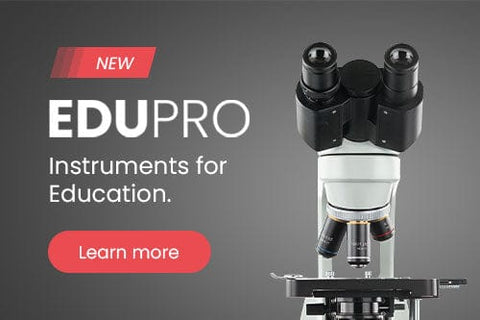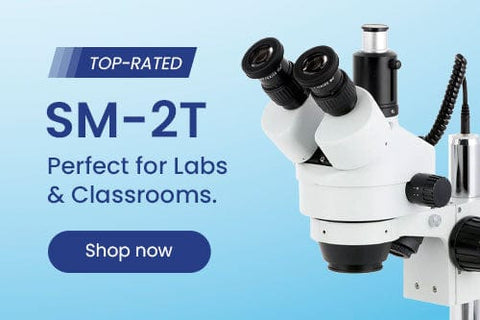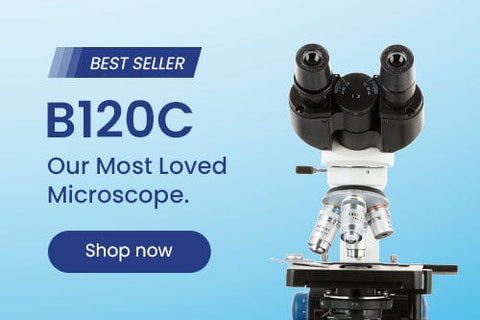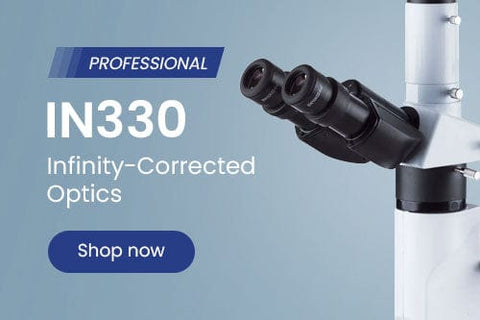- Microscopes
- Cameras
- Lab Supplies & Equipment
- Shop By Brand
- Lab Supplies by Category
- Analyzer Consumables
- Balances
- Bags
- Beakers
- Bench Scale Bases
- Bottles
- Bottletop Burettes
- Bottletop Dispensers
- Boxes
- Blank Microscope Slides & Cover Slips
- Blood Collection
- Caps
- Carboys
- Centrifuges
- Centrifuge Tubes
- Cold Storage
- Containers
- Cryogenic Vials
- Culture Tubes
- Cylinders
- Dispensers
- Digital Dry-Baths
- ESR Products
- False Bottom Tubes
- Flat Bottom
- Funnels
- Gel Documentation
- Glassware
- Glass Test Tubes
- Histology
- Homogenizers
- Hotplates-Stirrers
- Inoculation Loops and Spreaders
- Liquid Handling Products
- Manual-Electronic Pipettors-Pipettes
- Microscope Slides
- Overhead Stirrers
- Pipette Controller (Serological Filller)
- Pipette Tips
- Plastic Test Tubes
- PCR Tubes, Strips & Plates
- Racks
- Repeater Pipettor
- Rockers
- Rotary Evaporators
- Serological Pipettes
- Shakers
- Spectrophotometers
- Syringe Tips
- Sample Tubes
- School/Classroom Supplies
- Screwcap Test Tubes
- Self-Standing
- Test Tube Racks
- Test Tubes & Vials
- Transport & Storage Tubes
- Thermal Mixers
- Transfer Pipets
- Urinalysis
- Vacuum Pumps
- Weighing Dishes
- Lab Equipment
- Balances
- Bench Scale Bases
- Centrifuges
- Digital Dry-Baths
- Gel Documentation
- Homogenizers
- Hotplates-Stirrers
- Overhead Stirrers
- Pipettors
- Rockers
- Rotary Evaporators
- Shakers
- Serological Pipettes
- Spectrophotometers
- Thermal Mixers
- Vacuum Pumps
- Liquid Handling Products
- Manual-Electronic Pipettors-Pipettes
- Pipette Tips
- Racks
- Pipette Fillers-Controllers
- Repeater Pipettor
- Syringe Tips

Cost effective products and solutions designed to improve laboratory efficiency, safety and results.
SHOP BENCHMARK SCIENTIFIC >
- Slides & Accessories
- Slides
- Cameras
- Illuminators
- Adapters
- Eyepieces / Objectives
- Bulbs
- Magnifying Lamps
- Monitors and Tablets
- View All Categories
- Adapters
- DSLR Adapters
- USB Camera Adapters
- Ring Light Adapters
- Power Adapters
- Barlow Lens
- Books & Experiments Cards
- Bags & Cases
- Bags
- Cases
- Cameras
- Circuit Board Holders
- Cleaning Kits
- Condensers
- Darkfield
- Phase Contrast Kits
- Polarizing Kits
- Dust Covers
- Eye-Guards
- Eyepieces
- 20mm
- 23mm
- 30mm
- 30.5mm
- Filters
- Microscope Filters
- Illuminator Filters
- Fluorescence Kits
- Conversion Kits
- Filter Cubes
- Focusing Racks
- Fuses
- Illuminators
- Bulbs
- LED Illuminators
- Fiber Optic Illuminators
- Fluorescent Illuminators
- Ring Lights
- Stand Lights
- Goosenecks
- Gooseneck Attachments
- Immersion Oils
- Loupes
- Magnifying Lamps
- Clamp Lamps
- Desktop Lamps
- Rolling Stand Lamps
- Mechanical Stages
- Monitors and Tablets
- Calibration Slides & Stage Micrometers
- Stage Warmers
- Stain Kits
- Stands
- Articulating Arm Stands
- Boom Stands
- Table Stands
- Tweezers
- Other Accessories
- Shop By Industry
- Shop By Industry
- Botany
- Agronomy & Forestry
- Horticulture
- Phytopathology
- Chemistry
- Biochemistry
- Biotechnology
- Cannabis
- Pharmaceutics
- Consumables
- Beer & Wine
- Cosmetics
- Food & Beverage
- Electronics
- Circuit Boards & General Electronics
- Mobile Phone Repair
- Semiconductors & Wafers
- Environmental
- Asbestos
- Ecosystem Research
- Mud Logging
- Soil Treatment
- Water Treatment
- Forensics
- Ballistics
- Fingerprint Analysis
- Genetic Identification
- Hair & Fiber Analysis
- Handwriting Analysis
- Industrial
- Aerospace
- Automotive
- Dental Lab & Production
- Glass Industry
- Industrial Inspection
- Mechanical Parts
- Paper Industry
- Petrochemical
- Plastics
- Printing Industry
- Quality Assurance & Failure Analysis
- Textiles & Fibers
- Tool Making
- Wood Production
- Jewelry & Gemology
- Engraving
- Gemology
- Jewelry Repair
- Stone Setting
- Watch Repair
- Hobby
- Coins & Collecting
- Stamps
- Modeling & Assembly
- Sculpting
- Repair
- Telescopes
- Metallurgy
- Archaeology
- Geology
- Mining
- Petrology
- Medical & Microbiology
- Anatomopathology
- Bacteriology
- Biochemistry
- Cell Culture
- Cytology
- Dental Microbiology
- Dermatology
- Dissection
- Gout & Rheumatology
- Hair & Fiber Analysis
- Hair Transplant
- Fluorescence
- Hematology & Live Blood Analysis
- Histopathology
- Mycology
- Medical Devices
- Microsurgery
- Neuropathology
- Oncology
- Parasitology
- Pathology
- Semen Analysis
- Virology
- Veterinary & Zoology
- Breeding & Semen Analysis
- Entomology
- Fecal Smears & Floats
- Marine Biology
- Ornithology
- Veterinary Medicine
- Zoology
- Shop By Industry
- Students
- Telescopes
- Buy With Prime
- Sale
- Compound Microscopes
- Shop By Brand
- AmScope
- Euromex
- Omax
- Shop by Head Type
- Binocular
- Monocular
- Trinocular
- Multi-head & Training
- Shop By Specialty
- Brightfield
- Darkfield
- Phase Contrast
- Inverted
- EPIfluorescence
- Polarizing
- Digital Integrated
- Metallurgical
- Shop By Application
- Education
- Research
- Veterinary
- Compound With Digital Head
- Shop Best Sellers
- Shop All Compound
- Stereo Microscopes
- Shop By Brand
- AmScope
- Euromex
- Shop By Objective Type
- Fixed Power
- Zoom Power
- Single Lens
- Common Main Objective
- Shop By Stand Type
- Articulating Arms
- Boom Stands
- Gooseneck Stands
- Table Stands
- Other Stands
- Shop By Head Type
- Binocular
- Monocular
- Trinocular
- Simul-Focal
- Shop By Industry
- Video Inspection
- Industrial Inspection
- Microscope Heads
- Shop Stands
- Articulating Arm
- Boom Stands
- Table Stands
- Stereo With Digital Head
- Shop Best Sellers
- Shop All Stereo
- Specialized Microscopes
- Digital Microscopes
- Kids, Student Microscopes
| AmScope Blogs
Lab Safety Fundamentals: How to Properly Use Microscopes, Utensils and Other Equipment

Labs are fast-paced, exciting environments where participants tend to expect the unexpected. While a certain amount of serendipity can be a catalyst for a new discovery, everyone hopes the phrase “anything can happen” will apply to novel results, not accidents and setbacks. Luckily, scientists are an observant group who learn from their mistakes and a fairly universal set of safety fundamentals guides most labs.
Below, we talk about how to use equipment properly to maintain a safe environment. But remember: While these guidelines may cast a wide net, always be sure to consult your lab’s specific protocols before using any equipment. We will discuss what you can expect when you enter a lab, but every lab supervisor writes her own lab-appropriate rules that entrants must abide by.
Wear Sensible Clothing
Depending on the nature of your lab, you may encounter open flames, chemical irritants and/or pathogens on a daily basis. Lab coats, safety goggles and other protective gear go a long way towards shielding you from these hazards.

However, the clothing you wear underneath also needs to be sensible. Tight clothing that restricts your range of motion can be dangerous and impede your reaction time. Excessively loose or baggy clothes can get caught in machinery, knock over glassware or even catch on fire. Likewise, long hair should be kept tied back or under a cap to prevent a fire hazard. Open-toed shoes are another issue, as they expose your skin to chemicals or other substances that could be spilled on the floor. If you plan on spending time in the lab, make sure to wear comfortable clothes that fit properly, including close-toed shoes, and keep your hair tied back if it is longer than chin length.
Keep the Aisles Clear
Unexpected clutter can be a big issue in a small lab. While it may not sound like a huge deal, a book or backpack left on the floor can pose a serious hazard for your lab mates. Labs tend to be environments with many balls in the air at once–a variety of equipment packed into a small space, with people moving frequently back and forth to reach the microscopes or glassware they need to carry out their experiment. An untidy workspace can cause someone to trip and fall, not only putting them in harm’s way but also potentially sending their experiment back to the drawing board if the slides or dishes they were carrying shatter on the floor. By practicing lab cleanliness and exercising common courtesy, you can do your part in making the lab a safer place.

Maintain and Inspect
Regular lab inspections and equipment maintenance are major components of laboratory safety. Improper use of equipment, or the use of improperly maintained equipment, has resulted in many lab accidents. Environment, Health and Safety (EHS) departments help coordinate yearly lab inspections and safety trainings to ensure the lab and all of its members are up to date on equipment maintenance and safety certificates. While these inspections may be coordinated by the lab’s institution, it’s usually up to individual labs to arrange for maintenance and individual training. Conducting regular laboratory self-inspections is a great way to keep things in good shape in-between EHS inspections.
Know Your Exits
Fire safety is another big component in lab safety, especially in environments that work with open flames. All lab members should know where each fire extinguisher is located and should be instructed on the proper way to use them. Lab supervisors should ensure that everyone is familiar with the fastest and safest exit routes and that maps of the routes are posted prominently near each exit. Emergency phone numbers should be displayed near fire escape maps and by every phone. Upon entering the lab for the first time, all new lab members should be given instructions on how to use the safety equipment, including fire extinguishers, eye wash stations, first aid kits and safety showers. No one wants to have to make use of these tools, but they can save life or limb in an emergency situation when used correctly.

Use Microscopes Properly
Microscopes are key players in many labs, and they come with their own required safety protocols. As with any large electrical appliance, extreme care must be taken when engaging in any type of microscope parts replacement or repair. Instructions on how to power down the device and unplug it from its power source must be followed exactly to prevent electrical shock or harm to the machine. Instructions for microscope cleaning kits and other accessories that include liquid components should be read thoroughly to make sure they are not used in a way that could potentially damage the device.
Confocal microscopes that employ the use of lasers require a few extra precautions. Regardless of whether or not a beam is listed to operate at a safe level, you should never, ever look directly into it. Safety goggles help prevent ocular damage from lasers, as they help deflect beams that can be magnified or scattered off other surfaces present in the room. Beam stops help keep the laser contained in the appropriate environment, intercepting the beam before it can leave the controlled space. For labs that use eye guards to eliminate the interference of ambient light, proper measures should be taken to clean the guards before and after each use to prevent the spread of eye infection between microscope users.
Practice Caution with Lab Utensils
Forceps, tongs, dissecting pans, glassware and all other frequently used lab utensils should be kept in clearly marked and easily accessible locations. Keeping utensils clean and organized helps facilitate workflow and also eliminates the clutter that can potentially cause broken equipment or injury. Label the contents of each drawer, shelf and cubby so utensils are easy to find, and also easy to put back after they have been cleaned.

Always follow lab protocol regarding the method of cleaning. Never take shortcuts when it comes to sterilization. Wiping down the equipment with a simple ethanol solution may be all you need to do in some cases, whereas other procedures may require a trip to the autoclave afterward. Utensils should not be dropped in a sink when you’re finished using them. They should be carefully placed in a bin in a pre-designated place to be cleaned after use.
Handle Glassware with Care
One of the most commonly used types of lab equipment, glassware can pose surprising threats when not handled appropriately. A cursory inspection of glassware before use, to check for hairline cracks and chips, can prevent breaks and cuts. All cracked or chipped glassware should be disposed of properly. Every lab should have a clearly labeled waste bin specifically for glassware. Never dispose of scientific glassware in regular lab trash or recycling containers. Doing so could cause injury to those working in the lab as well as the janitorial staff.
Rapid changes in temperature can also pose a threat. Only borosilicate glass can undergo high heat or rapid temperature changes. Other types of glass could crack or even explode when used in this way, creating potential danger to those nearby. Likewise, stoppering glassware can also lead to explosions when not done properly. Glassware requires ventilation when exposed to high heat to avoid overpressurization. Keeping stoppers loose during high-heat procedures, and in the autoclave, will prevent the contents from overpressurizing. Even when following the above safety measures, protective eyewear should be worn at all times in the laboratory–especially when handling glassware.
Know How to Operate the Autoclave
Autoclaves are powerful devices that use high pressure and high temperatures to sterilize equipment. They can cause severe injury when not used properly, so it is imperative to follow all lab protocols when using these machines. Before use, it is important to check the drain screen. When the screen is blocked, a pocket of air can form, preventing proper sterilization. Clear all debris from the bottom of the autoclave before each use.
When loading the autoclave, only put similar materials together in the same cycle. For instance, porous organic materials should not be combined with strong oxidizing materials. When autoclaving glassware, do not seal bottles tightly. This could cause pressure to build up within the bottle, resulting in an explosion. Non-borosilicate glass should only be capped with aluminum foil, not a stopper. Only certain types of plastic are suitable for use in an autoclave. Polypropylene and polycarbonate can be used, whereas polyethylene and high-density polyethylene cannot.

Autoclaves produce a large amount of steam. When loading the autoclave, be sure to space the items in such a way that leaves room for steam to circulate around them. Make sure the door is closed completely and securely before initiating the cycle so steam and pressure are not lost.
Choosing the correct cycle is also necessary to ensure proper sterilization of your equipment. Your lab supervisor can train you on the proper cycles and protocols for different types of equipment. When the cycle has finished, be sure to wear the appropriate protective gear before opening the door. Eye protection, your lab coat, closed-toe shoes and heat-resistant gloves are all necessary safety precautions when dealing with high-temperature equipment.
Since the machine utilizes steam to perform its duties, open it cautiously, making sure to stand behind the door as you slowly open it. It’s also a good idea to leave the door open for 15 minutes after the cycle is complete to allow time for the equipment to cool, especially if there are any liquids involved.
Never Work Alone
Since so many things can happen in a lab environment, you should never handle chemicals, operate an autoclave or run experiments when you are on your own. Always schedule your time in the lab when other people are present. Many experiments require time points at all hours of the day or night, so make sure you have a buddy system in place for those middle-of-the-night trips to the lab.

If no one is present to assist you in case of possible injury, do not proceed with your work until you can find someone who can be there in the event of an emergency. Likewise, always check before you leave to make sure you are not putting someone else in the position of being alone. And never, ever leave an active experiment unattended, even if you only need to make a quick trip down the hall. Always make sure there is someone available to oversee what’s happening.
Lab Safety Requires Knowing the Rules
Every institution has its own set of protocols, and exact methods and practices can vary down to each individual lab. As a scientist, it is your responsibility to learn how your lab ensures the safety of its members and remains compliant with EHS standards. These lab safety fundamentals can help you get a basic idea of what to expect in a lab setting, but always be sure to learn the specific safety practices of your lab and help your fellow lab mates stay safe as well. Sticking closely to protocol ensures everyone’s time in the lab will be productive, safe and fun.
Free Shipping on orders $149+
Same day shipping for orders within the contiguous U.S.
Easy Returns
Hassle-free 30-day return policy. 100% satisfaction guarantee.
Quality Products
5-year warranty on AmScope microscopes.
Got a question?
Speak to our team of experts and find the products you need.
















